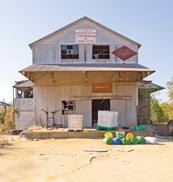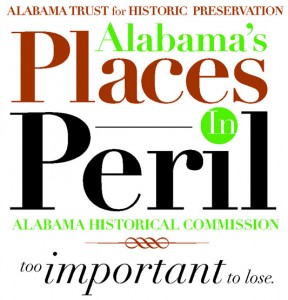 Click image to enlarge.
Click image to enlarge.
 Click image to enlarge. Click image to enlarge. Shown is the J.B. Hain Co. Cotton gin, Sardis, Dallas County. Cotton was Alabama’s principal economic engine before the Civil War, and it continued to play a major role in the state’s agricultural economy well into the twentieth century. Once ubiquitous across the Alabama landscape, the cotton gin served as the economic—and sometimes the social—hub of countless rural communities. But technological changes and the consolidation of gin facilities in the present cotton industry have made most gins obsolete, and in Alabama, as elsewhere, they are disappearing. Most gin buildings remaining today date from the early twentieth century, with a few rare survivors predating 1900. Those retaining original gin equipment are even harder to find.Cotton was Alabama’s principal economic engine before the Civil War, and it continued to play a major role in the state’s agricultural economy well into the twentieth century. Once ubiquitous across the Alabama landscape, the cotton gin served as the economic—and sometimes the social—hub of countless rural communities. But technological changes and the consolidation of gin facilities in the present cotton industry have made most gins obsolete, and in Alabama, as elsewhere, they are disappearing. Most gin buildings remaining today date from the early twentieth century, with a few rare survivors predating 1900. Those retaining original gin equipment are even harder to find. Th e cotton “gin” (short for “engine”) was designed to separate the cotton fibers from the seed. As cotton production boomed after 1820, gin manufacturing became a key part of early industrialization in the South, most notably with the 1833 founding of Daniel Pratt’s cotton gin factory at Prattville. Pratt’s company grew into the world’s largest gin factory, and in 1899 it merged with six other firms to form what ultimately became the Continental Eagle Corporation. Today, the state’s cotton production continues to decline, and gins are being idled. If the demise of the cotton gin is inevitable, some of these buildings off er exciting opportunities for new use and for preserving a virtual totem of the state’s cotton-rich past.
1 Comment
|
Alabama's Endangered Historic LandmarksEach year since 1994, Alabama Heritage has highlighted threatened historic sites throughout Alabama. The “Places in Peril” list has identified more than 215 imperiled historic resources throughout the state, and is compiled by the Alabama Historical Commission and the Alabama Trust for Historic Preservation. The locations highlight the results of deferred maintenance, perceived obsolescence, development pressures, and lack of funding—forces that now more than ever threaten our cultural legacy. But awareness is a powerful force, too, and can cultivate a renewed determination to be responsible stewards of our heritage. For more information, visit the AHC or the ATHP websites. Alabama Heritage is proud to bring to you a selection of the places designated as perilous. Please keep your comments to information relevant to the featured place in peril. Alabama Heritage reserves the right to delete any comment that we deem inappropriate. Archives
May 2024
|

 RSS Feed
RSS Feed